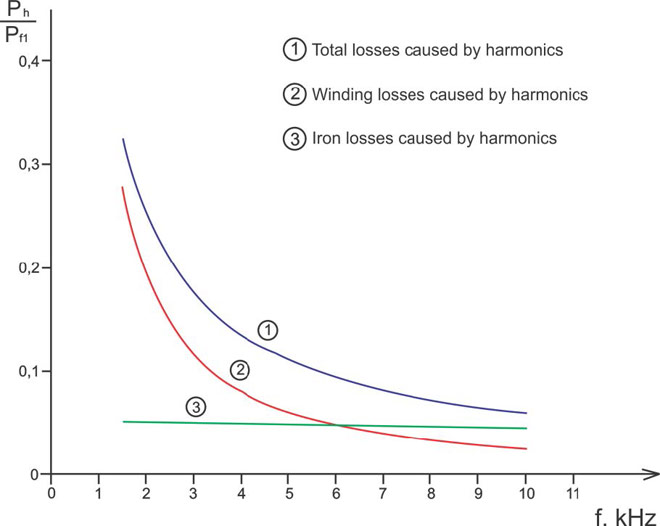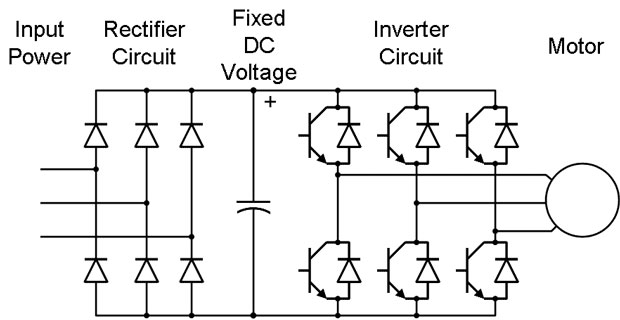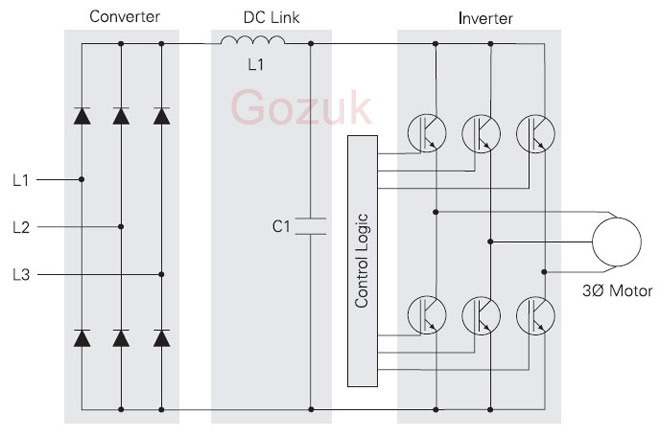Variable Frequency Drive Installation Considerations
Tags: VFD installation
Correct installation of variable frequency drives demands attention to vital factors such as location and environment, electrical connections grounding, supply voltage, and protective devices.
Over 50% of VFD failures are a result of improper installation and start-up. As such, you can avoid many problems by carefully planning your variable frequency drive installation prior to the actual work beginning. There are several key factors that must be considered to ensure a proper variable frequency drive installation.
The VFD installation procedure begins with a thorough reading of the VFD's manual. (That's the book we always put aside until we have problems and need answers). This manual will give you important information about receiving, storage, and planning for the installation before the equipment arrives. It's a good practice to make several copies of the manual; it seems they always end up in that great void with all the other lost manuals. Better yet, specify additional spare manuals for the VFD with your order.
Cooling and line power quality considerations
There are many important considerations for all industrial electronic equipment; however, the two most important are cooling and line power quality.
1) Cooling: variable frequency drive control units should be installed in locations where the maximum ambient temperature does not exceed 40 [degrees] C (104 [degrees] F). This is a common temperature rating for most units. If higher ambients are expected, derating of the variable frequency drive may be required.
You should avoid installing units in mezzanines, direct sunlight, or near external heat sources because these locations usually have unpredictable temperature rises. If you must install variable frequency drives in such areas, take steps to provide necessary cooling.
Proper cooling of the variable frequency drive's heat sink is essential for successful operation. Wall-mounted units employ a "chimney effect" for cooling of the heat sink and must be mounted against a smooth, flat, vertical surface. If a wall-mounted unit is to be installed in a free-standing position, then plywood or a sheet of metal should be fastened to the back of the unit to ensure that chimney-effect cooling will be achieved. Larger free-standing variable frequency drives require minimum clearances around them for sufficient air flow to circulate through them, assuring adequate cooling.
Altitude affects the heat dissipation capability of the heat sink and units in locations at 3300 ft (1000 m) above sea level must be derated. A common rule of thumb is a 2% derating for every 1000 ft above the 3300 ft altitude level.
2) Supply line power quality: The line voltage (supply) to the VFD input should not vary plus or minus 10% because most VFDs will trip via a protective fault. This voltage stability should be considered when running conductors to the VFD and voltage drops should be calculated for long runs.
Very often external control signals are used to start/stop and control the speed of a variable frequency drive. Control signal types can vary depending on the application. It's not unusual to have a 115V or 24V control circuit for start commands and a 4-20mA or 0-5VDC signal for speed control. These control signals must be run independently of each other as well as separate from any power wiring. Induced noises can produce erratic VFD behavior that is very difficult to troubleshoot.
Other variable frequency drive installation considerations
There are other installation considerations for variable frequency drives. These include electrical connections, grounding, fault protection, motor protection, and environmental parameters such as humidity and moisture.
1) Electrical connections: The sizing and installation of variable frequency drive line and load conductors should conform with the NEC and other appropriate local codes.
2) Grounding: For safe and dependable operation, all variable frequency drives must be properly grounded. This normally calls for a grounding conductor to be brought back to a single-point grounding location, usually selected to be at the service. In addition, a grounding conductor must be brought back from the motor to the variable frequency drive's internal grounding terminal. This direct motor ground to the variable frequency drive is required to minimize interference and for the ground-fault protection function of the VFD to operate properly.
3) Fault protection: Many variable frequency drives have short-circuit protection (usually in the form of fuses) already installed by the manufacturer. This is usually the case on larger hp units. Smaller units (1/3 to 5 hp) normally require external fuse protection. In either case, the selection and sizing of these fuses is critical for semiconductor protection in the event of a fault. The manufacturer's recommendations must be followed when installing or replacing fuses for the variable frequency drive. Be sure to torque-bolt fuses in place according to the manufacturer's specifications to assure fast operation of fuses in case of a fault.
4) Motor protection: All motors require overload protection. The most common practice is the use of a motor overcurrent relay system that will protect all three phases and protect against single-phasing. This type of protection will respond to motor overcurrent conditions of an overloaded motor, but will not detect over-temperature conditions.
A motor operating at reduced speeds will have reduced cooling; as a result, it may fail due to thermal breakdown of the motor windings insulation. Thus, the optimum protection for a motor is thermal sensing of the motor windings. This sensing is then interlocked with the variable frequency drive's control circuit. This is highly recommended for any motor that is to be operated for extended periods of time at low speeds.
5) Humidity and moisture: As is the case with all electrical and electronic equipment, high humidity and corrosive atmosphere's are a concern. VFD units should be installed in a noncorrosive location whenever possible, with ambient humidity ranging between 0 to 95% noncondensing.
Completing the installation
Installation of a variable frequency drive is no different than any other type of motor control. Common sense, along with the manufacturer's guide lines and adherence to the appropriate code requirements, are all that is needed.
At this point in time you'll probably want to power-up the variable frequency drive and give it a test. STOP...DON'T DO IT! Most fatal variable frequency drive failures occur about now.
A start-up procedure must be followed for the safe and correct start-up of the variable frequency drive. If the installation is performed by outside contractors, a notice should be placed on the variable frequency drive reading: Start-up by Facility Personnel Only.
Over 50% of VFD failures are a result of improper installation and start-up. As such, you can avoid many problems by carefully planning your variable frequency drive installation prior to the actual work beginning. There are several key factors that must be considered to ensure a proper variable frequency drive installation.
The VFD installation procedure begins with a thorough reading of the VFD's manual. (That's the book we always put aside until we have problems and need answers). This manual will give you important information about receiving, storage, and planning for the installation before the equipment arrives. It's a good practice to make several copies of the manual; it seems they always end up in that great void with all the other lost manuals. Better yet, specify additional spare manuals for the VFD with your order.
Cooling and line power quality considerations
There are many important considerations for all industrial electronic equipment; however, the two most important are cooling and line power quality.
1) Cooling: variable frequency drive control units should be installed in locations where the maximum ambient temperature does not exceed 40 [degrees] C (104 [degrees] F). This is a common temperature rating for most units. If higher ambients are expected, derating of the variable frequency drive may be required.
You should avoid installing units in mezzanines, direct sunlight, or near external heat sources because these locations usually have unpredictable temperature rises. If you must install variable frequency drives in such areas, take steps to provide necessary cooling.
Proper cooling of the variable frequency drive's heat sink is essential for successful operation. Wall-mounted units employ a "chimney effect" for cooling of the heat sink and must be mounted against a smooth, flat, vertical surface. If a wall-mounted unit is to be installed in a free-standing position, then plywood or a sheet of metal should be fastened to the back of the unit to ensure that chimney-effect cooling will be achieved. Larger free-standing variable frequency drives require minimum clearances around them for sufficient air flow to circulate through them, assuring adequate cooling.
Altitude affects the heat dissipation capability of the heat sink and units in locations at 3300 ft (1000 m) above sea level must be derated. A common rule of thumb is a 2% derating for every 1000 ft above the 3300 ft altitude level.
2) Supply line power quality: The line voltage (supply) to the VFD input should not vary plus or minus 10% because most VFDs will trip via a protective fault. This voltage stability should be considered when running conductors to the VFD and voltage drops should be calculated for long runs.
Very often external control signals are used to start/stop and control the speed of a variable frequency drive. Control signal types can vary depending on the application. It's not unusual to have a 115V or 24V control circuit for start commands and a 4-20mA or 0-5VDC signal for speed control. These control signals must be run independently of each other as well as separate from any power wiring. Induced noises can produce erratic VFD behavior that is very difficult to troubleshoot.
Other variable frequency drive installation considerations
There are other installation considerations for variable frequency drives. These include electrical connections, grounding, fault protection, motor protection, and environmental parameters such as humidity and moisture.
1) Electrical connections: The sizing and installation of variable frequency drive line and load conductors should conform with the NEC and other appropriate local codes.
2) Grounding: For safe and dependable operation, all variable frequency drives must be properly grounded. This normally calls for a grounding conductor to be brought back to a single-point grounding location, usually selected to be at the service. In addition, a grounding conductor must be brought back from the motor to the variable frequency drive's internal grounding terminal. This direct motor ground to the variable frequency drive is required to minimize interference and for the ground-fault protection function of the VFD to operate properly.
3) Fault protection: Many variable frequency drives have short-circuit protection (usually in the form of fuses) already installed by the manufacturer. This is usually the case on larger hp units. Smaller units (1/3 to 5 hp) normally require external fuse protection. In either case, the selection and sizing of these fuses is critical for semiconductor protection in the event of a fault. The manufacturer's recommendations must be followed when installing or replacing fuses for the variable frequency drive. Be sure to torque-bolt fuses in place according to the manufacturer's specifications to assure fast operation of fuses in case of a fault.
4) Motor protection: All motors require overload protection. The most common practice is the use of a motor overcurrent relay system that will protect all three phases and protect against single-phasing. This type of protection will respond to motor overcurrent conditions of an overloaded motor, but will not detect over-temperature conditions.
A motor operating at reduced speeds will have reduced cooling; as a result, it may fail due to thermal breakdown of the motor windings insulation. Thus, the optimum protection for a motor is thermal sensing of the motor windings. This sensing is then interlocked with the variable frequency drive's control circuit. This is highly recommended for any motor that is to be operated for extended periods of time at low speeds.
5) Humidity and moisture: As is the case with all electrical and electronic equipment, high humidity and corrosive atmosphere's are a concern. VFD units should be installed in a noncorrosive location whenever possible, with ambient humidity ranging between 0 to 95% noncondensing.
Completing the installation
Installation of a variable frequency drive is no different than any other type of motor control. Common sense, along with the manufacturer's guide lines and adherence to the appropriate code requirements, are all that is needed.
At this point in time you'll probably want to power-up the variable frequency drive and give it a test. STOP...DON'T DO IT! Most fatal variable frequency drive failures occur about now.
A start-up procedure must be followed for the safe and correct start-up of the variable frequency drive. If the installation is performed by outside contractors, a notice should be placed on the variable frequency drive reading: Start-up by Facility Personnel Only.
Post a Comment:
You may also like:
Featured Articles
Variable frequency drive Rectifier
 To understand variable frequency drive (VFD) better, it's necessary to explain some of the main parts of the variable frequency ...
To understand variable frequency drive (VFD) better, it's necessary to explain some of the main parts of the variable frequency ...
 To understand variable frequency drive (VFD) better, it's necessary to explain some of the main parts of the variable frequency ...
To understand variable frequency drive (VFD) better, it's necessary to explain some of the main parts of the variable frequency ...VFD controlled Induction motor ...
 This paper presents a procedure to measure the efficiency on an induction motor fed by a VFD by the all operation range to speed ...
This paper presents a procedure to measure the efficiency on an induction motor fed by a VFD by the all operation range to speed ...
 This paper presents a procedure to measure the efficiency on an induction motor fed by a VFD by the all operation range to speed ...
This paper presents a procedure to measure the efficiency on an induction motor fed by a VFD by the all operation range to speed ...What is VFD, How it works? - VFD ...
 VFD is shorted for Variable Frequency Drive (also known as AC Drives and Inverters) -- that's used to make an AC motor working in ...
VFD is shorted for Variable Frequency Drive (also known as AC Drives and Inverters) -- that's used to make an AC motor working in ...
 VFD is shorted for Variable Frequency Drive (also known as AC Drives and Inverters) -- that's used to make an AC motor working in ...
VFD is shorted for Variable Frequency Drive (also known as AC Drives and Inverters) -- that's used to make an AC motor working in ...VFD: Pulse Width Modulation (PWM)
 Pulse Width Modulation (PWM) VFDs provide a more sinusoidal current output to control frequency and voltage supplied to an AC ...
Pulse Width Modulation (PWM) VFDs provide a more sinusoidal current output to control frequency and voltage supplied to an AC ...
 Pulse Width Modulation (PWM) VFDs provide a more sinusoidal current output to control frequency and voltage supplied to an AC ...
Pulse Width Modulation (PWM) VFDs provide a more sinusoidal current output to control frequency and voltage supplied to an AC ...Variable frequency drive Advantages & ...
VFDs are good for variable speed, in a water pump this is used to maintain a steady pressure, they will smooth out variances in ...

VFD manufacturers
